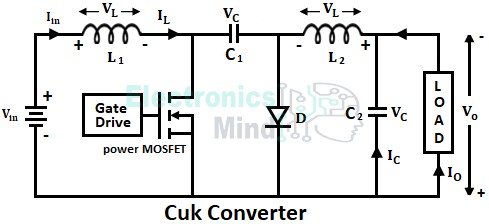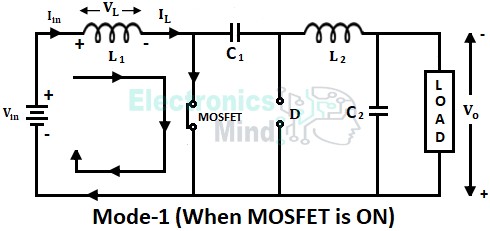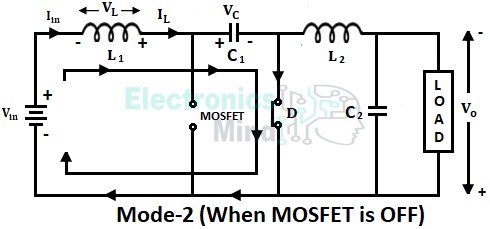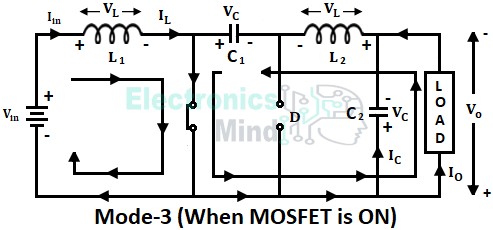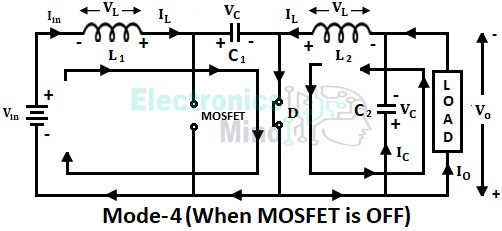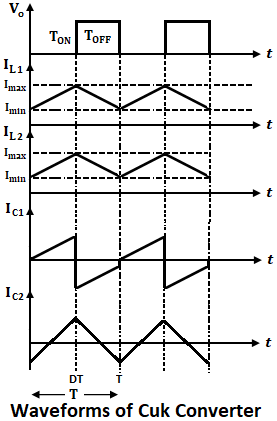What is Cuk Converter?
A Cuk converter is a dc-to-dc converter similar to a buck-boost converter by which we can obtain an output voltage either greater or lesser than the applied input voltage. Though a Cuk converter is similar to a buck-boost converter, its circuit construction overcomes the drawbacks of the buck-boost converter.
Need for Cuk Converter :
A Cuk converter is formed by combining the circuits of buck and boost converters. We know that a buck converter is a step-down type dc-to-dc converter i.e., the output voltage will be less than the input voltage, whereas a boost converter is a step-up type dc-to-dc converter i.e., the output voltage will be greater than the input voltage. The Cuk converter combines the merits of this both converters.
Even though there is a buck-boost converter that is similar to the Cuk converter. There are some drawbacks like the input current and charging current of the capacitor being discontinuous in the buck-boost converter. These drawbacks can be overcome by a Cuk converter circuit in which additional capacitors and inductors are used.
In a buck-boost converter, the energy transfer is associated with an inductor, whereas in the Cuk converter, the energy transfer is associated with a capacitor. The input current is continuous in the Cuk converter.
Circuit Diagram of Cuk Converter :
The below shows the circuit arrangement of the Cuk converter using a power MOSFET. The circuit of the Cuk converter is formed by combining the input side of a boost converter and the output side of a buck converter with a capacitor connected in between them.
The Cuk converter consists of more components compared to a buck, boost, and buck-boost converter i.e., two inductors, two capacitors, one diode, and one switch (MOSFET). The PWM pulses are given to the gate terminal of MOSFET to turn ON and OFF by which the output voltage is regulated.
The output voltage can be more or less than the input voltage i.e., the circuit can work in buck and boost mode which depends upon the duty ratio. The polarity of the output voltage in a Cuk converter is inverted (opposite of the input voltage).
Working of Cuk Converter :
In order to simplify and easily understand the working of the Cuk converter, the circuit operation is divided into four modes. Before starting the operation it should be noted that all the storage components in the circuit do not hold any charge in it.
Mode-1 (When MOSFET is ON) :
Since there is no charge present in inductors and capacitors initially. When the MOSFET is turned ON, the source current starts flowing the inductor L1, MOSFET, and back to the source as shown in the below figure.
During this condition, the inductor current starts rising and it will store energy with polarity from positive to negative in the direction of current flow. Also, there is no flow of source current to the load in this mode.
Mode-2 (When MOSFET is OFF) :
Once the MOSFET is turned OFF, due to a sudden drop in current through the inductor, the polarity of the inductor will be reversed. Now the charged inductor L1 in the previous mode will start discharging in the reverse direction. Here in addition to the energy dissipating from the inductor, the current will flow from the source to the inductor.
Thus the input voltage will be added to the inductor voltage, due to which the current starts flowing through the capacitor and the capacitor gets charged by the inductor. This flow of current through the capacitor makes the diode forward biased. The capacitor allows the flow of current through it because it is not completely DC (since the current provided by the inductor is not constant).
The current flow path when the MOSFET is turned OFF is from the source to inductor L1, capacitor C1, diode, and back to the source as shown above. Similar to mode-1 no power is supplied to the load in this mode.
Mode-3 (When MOSFET is ON) :
Now when the MOSFET has turned ON again, the inductor L1 will be charged again similarly as seen in mode-1. As capacitor C1 is charged in mode-2, it starts discharging and dissipates energy to the load. The discharging of the capacitor C1 will be through MOSFET, capacitor C2, load, inductor L2, and back to the capacitor as shown below.
Simultaneously when the capacitor is discharging, inductor L2 will be charged with energy provided by the capacitor C1 as shown above. Due to flow reverse current, the diode will be in reverse bias and hence it remains in the OFF state in this mode.
Mode-4 (When MOSFET is OFF) :
Again when the MOSFET is turned OFF, mode-2 will be repeated in which capacitor C1 will be charged with inductor energy by forward biasing the diode. In addition to this, the charged inductor L2 in mode-3 will start discharging in the reverse direction through the same diode and transfers its energy to the load as shown below.
Therefore from the above four operation modes of the Cuk converter, we can conclude that. When the MOSFET is in the ON state, inductor L1 gets charged and capacitor C1 will supply its energy to load.
When the MOSFET is in the OFF state, capacitor C1 gets charged and inductor L2 supplies its energy to load. The capacitor C1 acts as the medium for transferring energy from source to load. The below shows the waveforms for voltages and currents.
Advantages of Cuk Converter :
- Compared to the buck-boost converter, the efficiency of a Cuk converter is high.
- The two inductors present on the input and output sides of the converter reduce ripples in the current.
- The two inductors can be made to share a common core which in turn simplifies construction.
- The LC components in the circuit filter both input and output currents thus reducing electromagnetic interference.
- The input and output current both are continuous.
- The switching losses are less in the Cuk converter.
Disadvantages of Cuk Converter :
- High-rating capacitor is needed in high-power applications.
- All the current from the source to load as to go through capacitor C1 and the voltage across the capacitor reverses each half cycle, thus the capacitor must be non-polarized.
- Since MOSFET has to carry the currents of two inductors high peak current will flow through it.
Applications of Cuk Converter :
- The Cuk converter circuit is used to maintain fixed output voltage in dc applications services.
- This type of converter circuit is used as a voltage regulator in renewable energy-based power generation systems to supply constant output voltage to the load.
- It can be used as the power factor correction circuit.

